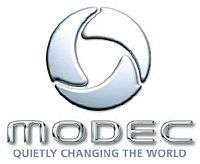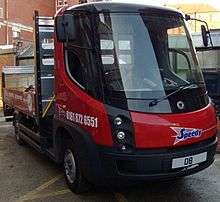Modec
 | |
| Private | |
| Industry | Manufacturing |
| Fate | Assets & IP sold to Navistar International |
| Founded | October 2004 |
| Defunct | March 2011 |
| Headquarters | Coventry, United Kingdom |
Key people |
Jamie Borwick, (Chairman) Bill Gillespie, (CEO) |
| Products | Zero Emission Commercial Vehicles |
| Revenue | Undisclosed |
| Undisclosed | |
Number of employees | 70 (2007) |
| Website | www.modeczev.com |




Modec was a Coventry, UK electric vehicle manufacturer, specialising in Commercial vehicles in the N2 category.[2] It unveiled its first model in April 2006 and announced its intention to commence series production in March 2007, with the first production vehicles destined for Tesco. Following a long-term decline in sales, it entered administration in March 2011, with all remaining assets and intellectual property sold to Navistar International.
History
- 2002
- eMercury project commenced within London Taxis International (a division of Manganese Bronze). The project was led by Jevon Thorpe, designer of the TX1London Taxi. Some development funding received from the Energy Savings Trust (EST), part of the Department of Trade and Industry.
- 2004
- Three eMercury prototypes demonstrated - one conventional lead-acid battery powered, one hybrid vehicle utilising a nickel metal hydride battery and one utilising a high energy molten salt battery mounted in a removable cassette between the chassis rails.
- Manganese Bronze announces its decision to focus on its taxi business. The eMercury project bought by Jamie Borwick, former CEO & Chairman of Manganese Bronze, who creates Modec Limited as part of Borwick Group.
- Splits with drivetrain supplier Azure Dynamics, in favour of Zytek, commences development of production vehicles
- 2006
- Announces partnerships with Lex Logistics for customer service, GE Commercial Finance for vehicle finance and battery rental and Axeon Power for battery cassette assemblies containing Zebra battery technology.
- Unveils next generation of production intent vehicles at SMMT Commercial Vehicle Show. Fitted with an 85 kWh battery pack, they have a 2-2.5 tonne payload, a governed top speed of 50 mph and a range in excess of 100 miles on a typical urban duty cycle. Maximum torque of 300 Newton metres is delivered from rest, resulting in lively acceleration. Zebra batteries are used.
- 2007
- Coventry production facility officially opened by the Rt Hon David Cameron MP.
- Announcement of that the first vehicles built will be delivered to Tesco for home grocery deliveries.
- Other deliveries included Center Parcs at their Elveden Forest park for servicing use, Accord, Amey, Speedy Hire, Hildon Water, London Borough of Islington and others.
- 2008
- 100th Modec vehicle produced, production at the Coventry plant ramping up according to plan (maximum capacity 5,000 vehicles per annum).
- London dealer network expands to six sites; Distributors appointed in the Netherlands and Ireland
- UPS has ordered Modec electric vans for its UK and German fleets. Energy costs are play a huge part in the potential profitability of package delivery companies like UPS, DHL and FedEx.[3]
- 2009
- Modec is the first electric vehicle in the N2 class to attain European Whole Vehicle Type Approval.[4] Modec has entered into a joint venture with Navistar International for North and South America. The Joint venture is named Navistar-Modec EV Alliance.[5]
- 2010
- Navistar began deliveries of its eStar electric van manufactured in Wakarusa, Indiana under licensed technology from Modec's zero-emissions delivery van.[1]
Closure
Following a long-term decline in sales with a total production of around 400 vehicles, and following the failure of a rescue deal with Navistar, Modec entered administration in March 2011 with debts of over £40m.[6] Navistar subsequently bought the intellectual property rights from administrators Zolfo Cooper.[7]
Following the closure of the business and sale of the assets, Liberty Electric Cars hired the entire Modec engineering team and set up a new subsidiary “Liberty E-Tech”.[8] After failing in January 2011 to agree a deal with Navistar to buy the brand, in July 2011 Liberty launched a service called “e-Care” to service and maintain Modec vehicles, which presently covers the UK, France, Germany and Dubai.[9]
Technical
The only product of the Modec company was the Modec EV commercial vehicle. It was produced in three version; a chassis cab, box van and a dropside. All three shared a common wheelbase of 141.7 in (3.60 m) and a steel ladder frame chassis. The Modec has a kerb weight of 3.3 tonnes and a max gross capacity of 6.05 tonnes.[10]
The vehicles use an 102 bhp (76 kW; 103 PS) motor with 221 lb·ft (300 N·m) of torque and an exchangeable lead-acid battery which is charged from an external charger than requires a 32amp 3-phase supply to charge the vehicle for 6 hours, it also has options for Lithium-Iron Phosphate or Sodium Nickel chloride batteries.
It has a 100-mile (160 km) range and a 50 mph (80 km/h) top speed.[11]
See also
References
- ↑ http://www.unece.org/trans/main/wp29/wp29wgs/wp29gen/wp29fdoc/78r1a2e.pdf
- ↑ "Europe: UPS Orders Modec Electric Vans for UK and German Fleets | 4EVRiders.org - Charging Locator and News on Electric and Plug-in Hybrid Vehicles". 4EVRiders.org. 2008-11-20. Retrieved 2010-06-26.
- ↑ "Millbrook Offers Modec the Right Kind of Approval". PressReleasePoint. Retrieved 2010-06-26.
- ↑ "Modec finalises joint venture with Navistar International". Fleetnews.co.uk. Retrieved 2010-06-26.
- ↑ Shankleman, Jessica (8 March 2011). "Could Modec crash kill off UK's commercial electric vehicle market?". The Guardian. Retrieved 15 May 2012.
- ↑ Anna Blackaby (April 8, 2011). "Modec electric van know-how sold to US firm Navistar". birminghampost.net. Retrieved 2011-04-19.
- ↑ "Ex Modec engineering team joins forces with Liberty Electric Cars". Fleet News. June 2, 2011. Retrieved 2012-04-11.
- ↑ "Liberty Electric Cars launches Liberty E-Care". Fleet News. September 12, 2011. Retrieved 2012-04-11.
- ↑ "Modec Brochure". Modec. Retrieved 15 May 2012.
- ↑ Presentation about Modec vehicles form Paul o'Dowd their Nation Sales manager
External links
| Wikimedia Commons has media related to Modec. |
- Modec Limited
- Interview with Lord Jamie Borwick with Financial Times
- Interview with Lord Jamie Borwick at REAL BUSINESS about Modec
- Video of Robert Llewellyn driving the van from Brighton to London as part of an eco-rally